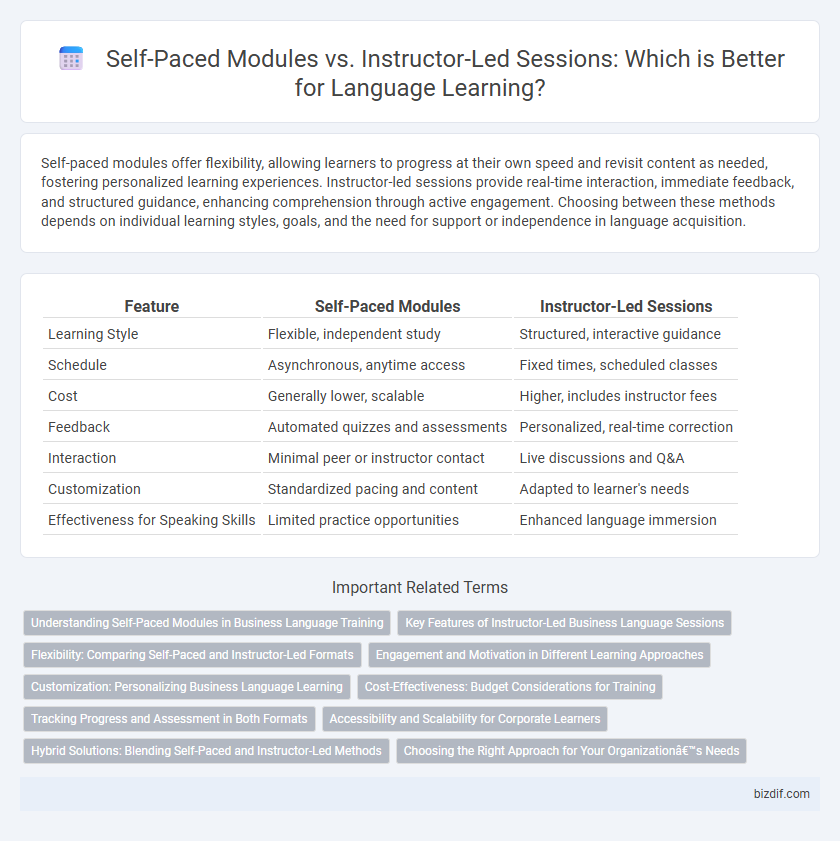Self-paced modules offer flexibility, allowing learners to progress at their own speed and revisit content as needed, fostering personalized learning experiences. Instructor-led sessions provide real-time interaction, immediate feedback, and structured guidance, enhancing comprehension through active engagement. Choosing between these methods depends on individual learning styles, goals, and the need for support or independence in language acquisition.
Table of Comparison
| Feature | Self-Paced Modules | Instructor-Led Sessions |
|---|---|---|
| Learning Style | Flexible, independent study | Structured, interactive guidance |
| Schedule | Asynchronous, anytime access | Fixed times, scheduled classes |
| Cost | Generally lower, scalable | Higher, includes instructor fees |
| Feedback | Automated quizzes and assessments | Personalized, real-time correction |
| Interaction | Minimal peer or instructor contact | Live discussions and Q&A |
| Customization | Standardized pacing and content | Adapted to learner's needs |
| Effectiveness for Speaking Skills | Limited practice opportunities | Enhanced language immersion |
Understanding Self-Paced Modules in Business Language Training
Self-paced modules offer flexible, personalized learning experiences that allow learners to progress at their own speed, crucial for mastering business-specific terminology and communication skills. These modules incorporate interactive exercises, real-world scenarios, and multimedia resources that cater to diverse learning styles, enhancing retention and practical application. Businesses benefit from scalable training solutions that minimize disruptions and accommodate varying employee schedules without sacrificing instructional quality.
Key Features of Instructor-Led Business Language Sessions
Instructor-led business language sessions provide real-time interaction with expert instructors, enabling immediate feedback and personalized guidance tailored to professional communication needs. These sessions emphasize structured learning paths, active speaking practice, and cultural context integration to enhance business fluency and confidence. Collaborative activities and role-playing simulations replicate workplace scenarios, fostering practical language application and critical soft skills development.
Flexibility: Comparing Self-Paced and Instructor-Led Formats
Self-paced modules offer unparalleled flexibility, allowing learners to access materials anytime and progress at their own speed, ideal for busy schedules or diverse learning paces. Instructor-led sessions provide structured timelines and real-time interaction, which can enhance motivation and immediate clarification but require fixed attendance. Choosing between these formats depends on individual preferences for autonomy versus guided support in achieving language proficiency.
Engagement and Motivation in Different Learning Approaches
Self-paced modules offer learners autonomy and flexibility, fostering intrinsic motivation through personalized pacing, while instructor-led sessions enhance engagement via real-time interaction and immediate feedback. Learners in instructor-led environments often benefit from social dynamics and collaborative activities that boost motivation, whereas self-paced learners need strong self-regulation skills to maintain consistent engagement. Balancing these approaches by integrating interactive content and periodic instructor support can optimize motivation and sustained learner engagement across diverse learning preferences.
Customization: Personalizing Business Language Learning
Self-paced modules offer tailored flexibility that adapts to individual learning speeds and specific business terminology, enhancing personalized language acquisition. Instructor-led sessions provide real-time interaction and customized feedback, allowing immediate adjustments based on learner progress and industry-specific needs. Combining both formats maximizes customization, ensuring business language learning aligns precisely with professional goals and communication challenges.
Cost-Effectiveness: Budget Considerations for Training
Self-paced modules offer significant cost savings by reducing expenses related to instructors, facility rentals, and scheduled class times, making them ideal for organizations with tight training budgets. Instructor-led sessions often incur higher costs due to live facilitation fees and logistical arrangements but can provide personalized guidance and immediate feedback, potentially enhancing learning outcomes. Evaluating the total cost of ownership, including long-term scalability and learner engagement, helps determine the most budget-efficient approach for language instruction programs.
Tracking Progress and Assessment in Both Formats
Self-paced modules offer automated progress tracking through embedded quizzes and real-time analytics, enabling learners to monitor their achievements independently. Instructor-led sessions provide personalized assessment via direct feedback and interactive evaluations, fostering immediate clarification and targeted improvement. Combining both formats enhances comprehensive tracking and supports diverse learner needs through varied assessment methods.
Accessibility and Scalability for Corporate Learners
Self-paced modules offer unparalleled accessibility by allowing corporate learners to engage with content anytime and anywhere, accommodating diverse schedules and learning paces. Instructor-led sessions provide real-time interaction and immediate feedback, but scalability is limited by instructor availability and session scheduling constraints. Combining both approaches enhances learning flexibility and maximizes accessibility while addressing the scalability needs of large, geographically dispersed corporate audiences.
Hybrid Solutions: Blending Self-Paced and Instructor-Led Methods
Hybrid language instruction solutions combine the flexibility of self-paced modules with the personalized guidance of instructor-led sessions, creating a balanced learning experience. This blended approach enhances learner engagement by accommodating diverse learning styles and schedules, resulting in improved retention and practical language use. Integrating interactive multimedia content with real-time instructor feedback fosters effective skill development and learner autonomy.
Choosing the Right Approach for Your Organization’s Needs
Self-paced modules offer flexible learning schedules that accommodate diverse employee availability, enhancing accessibility and individualized pace. Instructor-led sessions foster real-time interaction, immediate feedback, and collaborative learning experiences that can improve comprehension and engagement. Selecting the right approach depends on organizational goals, workforce demographics, and the need for personalized support versus scalability and convenience.
Self-Paced Modules vs Instructor-Led Sessions Infographic

 bizdif.com
bizdif.com